Nursing Interventions for Obesity, Patient-Centered Care, and Safety
VerifiedAdded on 2023/02/01
|8
|2091
|24
Discussion Board Post
AI Summary
This discussion post delves into community health nursing interventions, primarily focusing on strategies to address obesity. The author identifies physical activity community strategies and creating healthy food environments as effective approaches. The post also examines patient-centered care, outlining its principles and barriers to implementation, such as financial constraints and lack of respect. Furthermore, the assignment explores measures to improve patient safety, including limiting shift durations, enhancing communication, and implementing double patient identification. The author concludes by emphasizing their role as a healthcare professional in protecting patients through monitoring, medication verification, patient education, and promoting a culture of safety.
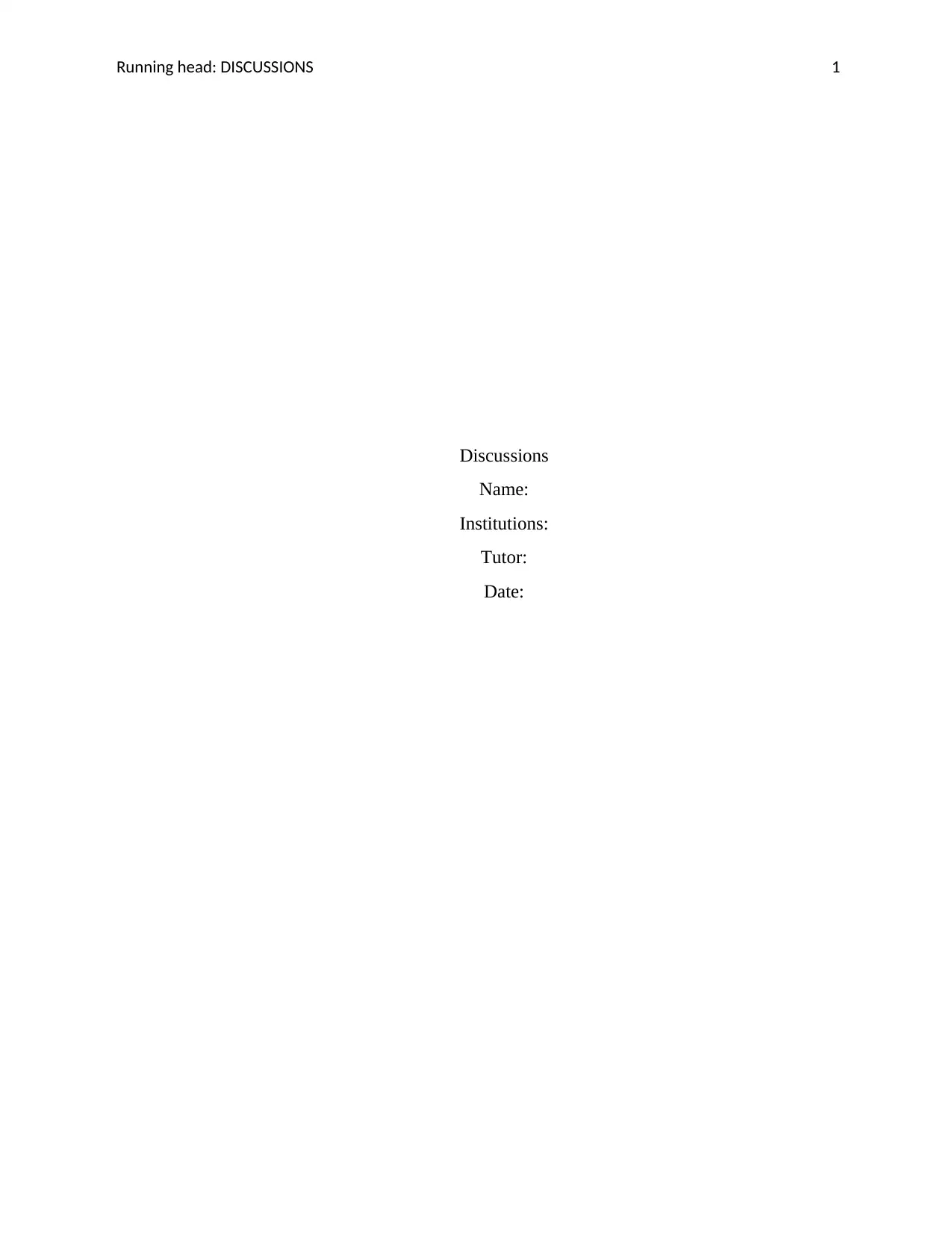
Running head: DISCUSSIONS 1
Discussions
Name:
Institutions:
Tutor:
Date:
Discussions
Name:
Institutions:
Tutor:
Date:
Paraphrase This Document
Need a fresh take? Get an instant paraphrase of this document with our AI Paraphraser
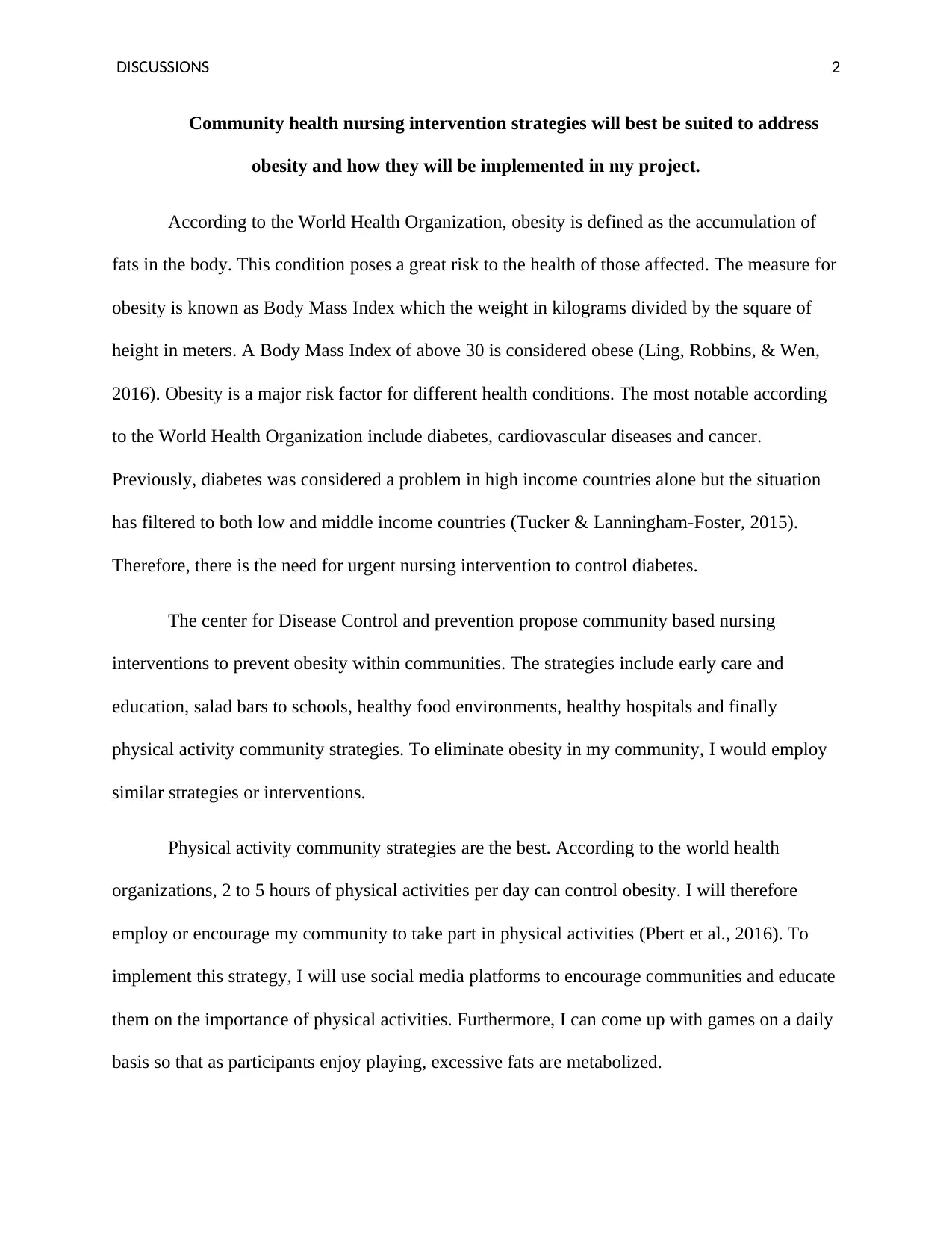
DISCUSSIONS 2
Community health nursing intervention strategies will best be suited to address
obesity and how they will be implemented in my project.
According to the World Health Organization, obesity is defined as the accumulation of
fats in the body. This condition poses a great risk to the health of those affected. The measure for
obesity is known as Body Mass Index which the weight in kilograms divided by the square of
height in meters. A Body Mass Index of above 30 is considered obese (Ling, Robbins, & Wen,
2016). Obesity is a major risk factor for different health conditions. The most notable according
to the World Health Organization include diabetes, cardiovascular diseases and cancer.
Previously, diabetes was considered a problem in high income countries alone but the situation
has filtered to both low and middle income countries (Tucker & Lanningham-Foster, 2015).
Therefore, there is the need for urgent nursing intervention to control diabetes.
The center for Disease Control and prevention propose community based nursing
interventions to prevent obesity within communities. The strategies include early care and
education, salad bars to schools, healthy food environments, healthy hospitals and finally
physical activity community strategies. To eliminate obesity in my community, I would employ
similar strategies or interventions.
Physical activity community strategies are the best. According to the world health
organizations, 2 to 5 hours of physical activities per day can control obesity. I will therefore
employ or encourage my community to take part in physical activities (Pbert et al., 2016). To
implement this strategy, I will use social media platforms to encourage communities and educate
them on the importance of physical activities. Furthermore, I can come up with games on a daily
basis so that as participants enjoy playing, excessive fats are metabolized.
Community health nursing intervention strategies will best be suited to address
obesity and how they will be implemented in my project.
According to the World Health Organization, obesity is defined as the accumulation of
fats in the body. This condition poses a great risk to the health of those affected. The measure for
obesity is known as Body Mass Index which the weight in kilograms divided by the square of
height in meters. A Body Mass Index of above 30 is considered obese (Ling, Robbins, & Wen,
2016). Obesity is a major risk factor for different health conditions. The most notable according
to the World Health Organization include diabetes, cardiovascular diseases and cancer.
Previously, diabetes was considered a problem in high income countries alone but the situation
has filtered to both low and middle income countries (Tucker & Lanningham-Foster, 2015).
Therefore, there is the need for urgent nursing intervention to control diabetes.
The center for Disease Control and prevention propose community based nursing
interventions to prevent obesity within communities. The strategies include early care and
education, salad bars to schools, healthy food environments, healthy hospitals and finally
physical activity community strategies. To eliminate obesity in my community, I would employ
similar strategies or interventions.
Physical activity community strategies are the best. According to the world health
organizations, 2 to 5 hours of physical activities per day can control obesity. I will therefore
employ or encourage my community to take part in physical activities (Pbert et al., 2016). To
implement this strategy, I will use social media platforms to encourage communities and educate
them on the importance of physical activities. Furthermore, I can come up with games on a daily
basis so that as participants enjoy playing, excessive fats are metabolized.
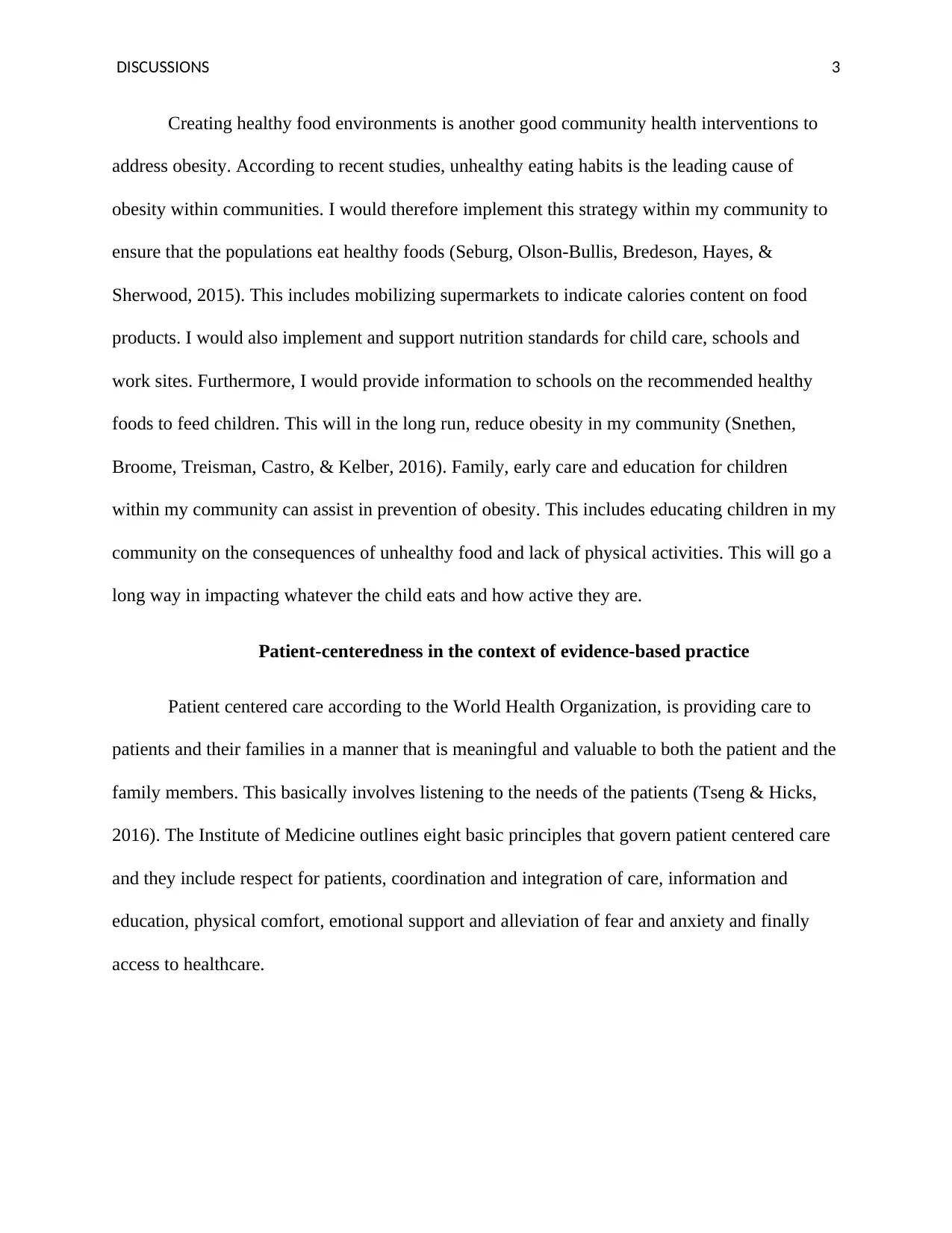
DISCUSSIONS 3
Creating healthy food environments is another good community health interventions to
address obesity. According to recent studies, unhealthy eating habits is the leading cause of
obesity within communities. I would therefore implement this strategy within my community to
ensure that the populations eat healthy foods (Seburg, Olson-Bullis, Bredeson, Hayes, &
Sherwood, 2015). This includes mobilizing supermarkets to indicate calories content on food
products. I would also implement and support nutrition standards for child care, schools and
work sites. Furthermore, I would provide information to schools on the recommended healthy
foods to feed children. This will in the long run, reduce obesity in my community (Snethen,
Broome, Treisman, Castro, & Kelber, 2016). Family, early care and education for children
within my community can assist in prevention of obesity. This includes educating children in my
community on the consequences of unhealthy food and lack of physical activities. This will go a
long way in impacting whatever the child eats and how active they are.
Patient-centeredness in the context of evidence-based practice
Patient centered care according to the World Health Organization, is providing care to
patients and their families in a manner that is meaningful and valuable to both the patient and the
family members. This basically involves listening to the needs of the patients (Tseng & Hicks,
2016). The Institute of Medicine outlines eight basic principles that govern patient centered care
and they include respect for patients, coordination and integration of care, information and
education, physical comfort, emotional support and alleviation of fear and anxiety and finally
access to healthcare.
Creating healthy food environments is another good community health interventions to
address obesity. According to recent studies, unhealthy eating habits is the leading cause of
obesity within communities. I would therefore implement this strategy within my community to
ensure that the populations eat healthy foods (Seburg, Olson-Bullis, Bredeson, Hayes, &
Sherwood, 2015). This includes mobilizing supermarkets to indicate calories content on food
products. I would also implement and support nutrition standards for child care, schools and
work sites. Furthermore, I would provide information to schools on the recommended healthy
foods to feed children. This will in the long run, reduce obesity in my community (Snethen,
Broome, Treisman, Castro, & Kelber, 2016). Family, early care and education for children
within my community can assist in prevention of obesity. This includes educating children in my
community on the consequences of unhealthy food and lack of physical activities. This will go a
long way in impacting whatever the child eats and how active they are.
Patient-centeredness in the context of evidence-based practice
Patient centered care according to the World Health Organization, is providing care to
patients and their families in a manner that is meaningful and valuable to both the patient and the
family members. This basically involves listening to the needs of the patients (Tseng & Hicks,
2016). The Institute of Medicine outlines eight basic principles that govern patient centered care
and they include respect for patients, coordination and integration of care, information and
education, physical comfort, emotional support and alleviation of fear and anxiety and finally
access to healthcare.
⊘ This is a preview!⊘
Do you want full access?
Subscribe today to unlock all pages.

Trusted by 1+ million students worldwide
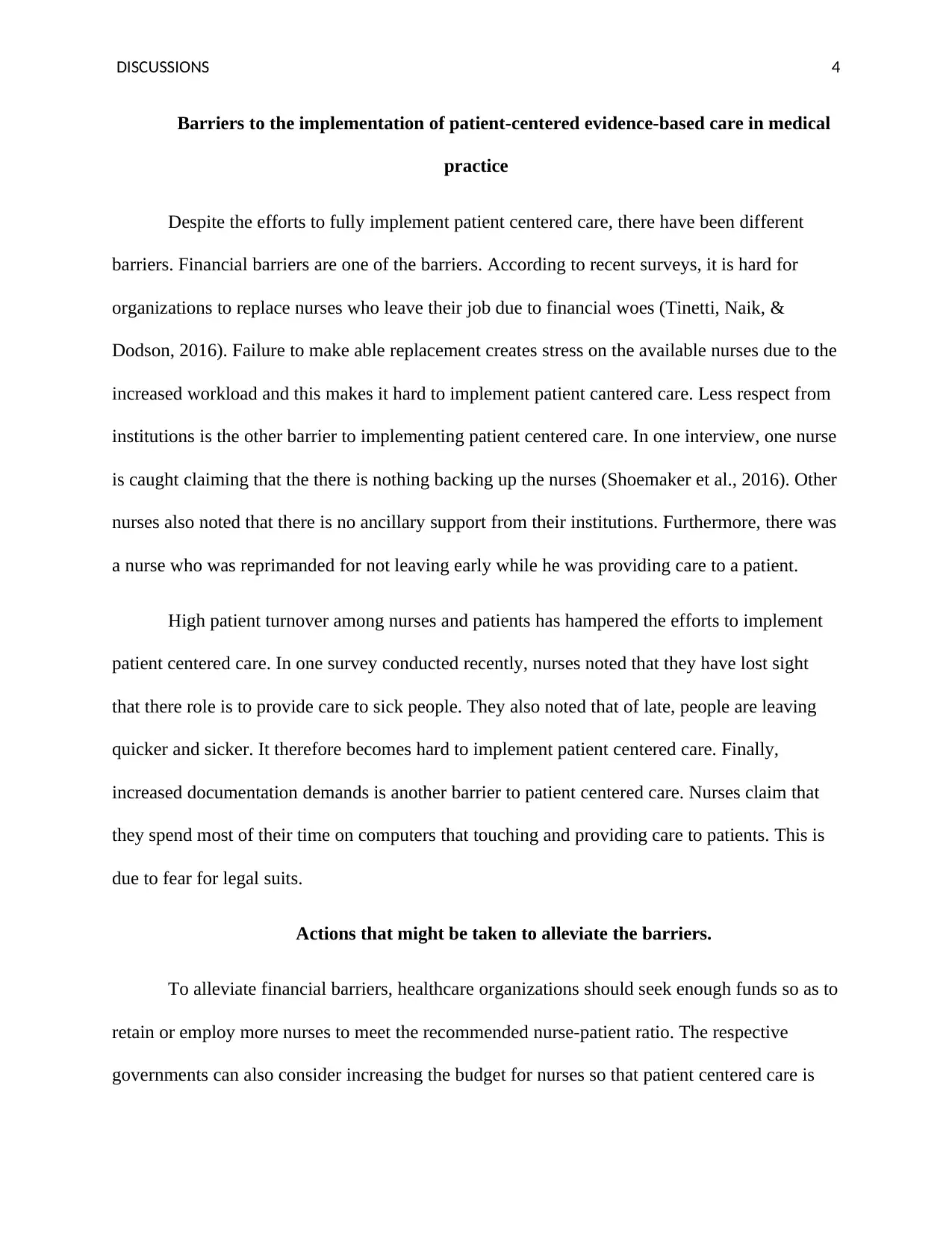
DISCUSSIONS 4
Barriers to the implementation of patient-centered evidence-based care in medical
practice
Despite the efforts to fully implement patient centered care, there have been different
barriers. Financial barriers are one of the barriers. According to recent surveys, it is hard for
organizations to replace nurses who leave their job due to financial woes (Tinetti, Naik, &
Dodson, 2016). Failure to make able replacement creates stress on the available nurses due to the
increased workload and this makes it hard to implement patient cantered care. Less respect from
institutions is the other barrier to implementing patient centered care. In one interview, one nurse
is caught claiming that the there is nothing backing up the nurses (Shoemaker et al., 2016). Other
nurses also noted that there is no ancillary support from their institutions. Furthermore, there was
a nurse who was reprimanded for not leaving early while he was providing care to a patient.
High patient turnover among nurses and patients has hampered the efforts to implement
patient centered care. In one survey conducted recently, nurses noted that they have lost sight
that there role is to provide care to sick people. They also noted that of late, people are leaving
quicker and sicker. It therefore becomes hard to implement patient centered care. Finally,
increased documentation demands is another barrier to patient centered care. Nurses claim that
they spend most of their time on computers that touching and providing care to patients. This is
due to fear for legal suits.
Actions that might be taken to alleviate the barriers.
To alleviate financial barriers, healthcare organizations should seek enough funds so as to
retain or employ more nurses to meet the recommended nurse-patient ratio. The respective
governments can also consider increasing the budget for nurses so that patient centered care is
Barriers to the implementation of patient-centered evidence-based care in medical
practice
Despite the efforts to fully implement patient centered care, there have been different
barriers. Financial barriers are one of the barriers. According to recent surveys, it is hard for
organizations to replace nurses who leave their job due to financial woes (Tinetti, Naik, &
Dodson, 2016). Failure to make able replacement creates stress on the available nurses due to the
increased workload and this makes it hard to implement patient cantered care. Less respect from
institutions is the other barrier to implementing patient centered care. In one interview, one nurse
is caught claiming that the there is nothing backing up the nurses (Shoemaker et al., 2016). Other
nurses also noted that there is no ancillary support from their institutions. Furthermore, there was
a nurse who was reprimanded for not leaving early while he was providing care to a patient.
High patient turnover among nurses and patients has hampered the efforts to implement
patient centered care. In one survey conducted recently, nurses noted that they have lost sight
that there role is to provide care to sick people. They also noted that of late, people are leaving
quicker and sicker. It therefore becomes hard to implement patient centered care. Finally,
increased documentation demands is another barrier to patient centered care. Nurses claim that
they spend most of their time on computers that touching and providing care to patients. This is
due to fear for legal suits.
Actions that might be taken to alleviate the barriers.
To alleviate financial barriers, healthcare organizations should seek enough funds so as to
retain or employ more nurses to meet the recommended nurse-patient ratio. The respective
governments can also consider increasing the budget for nurses so that patient centered care is
Paraphrase This Document
Need a fresh take? Get an instant paraphrase of this document with our AI Paraphraser
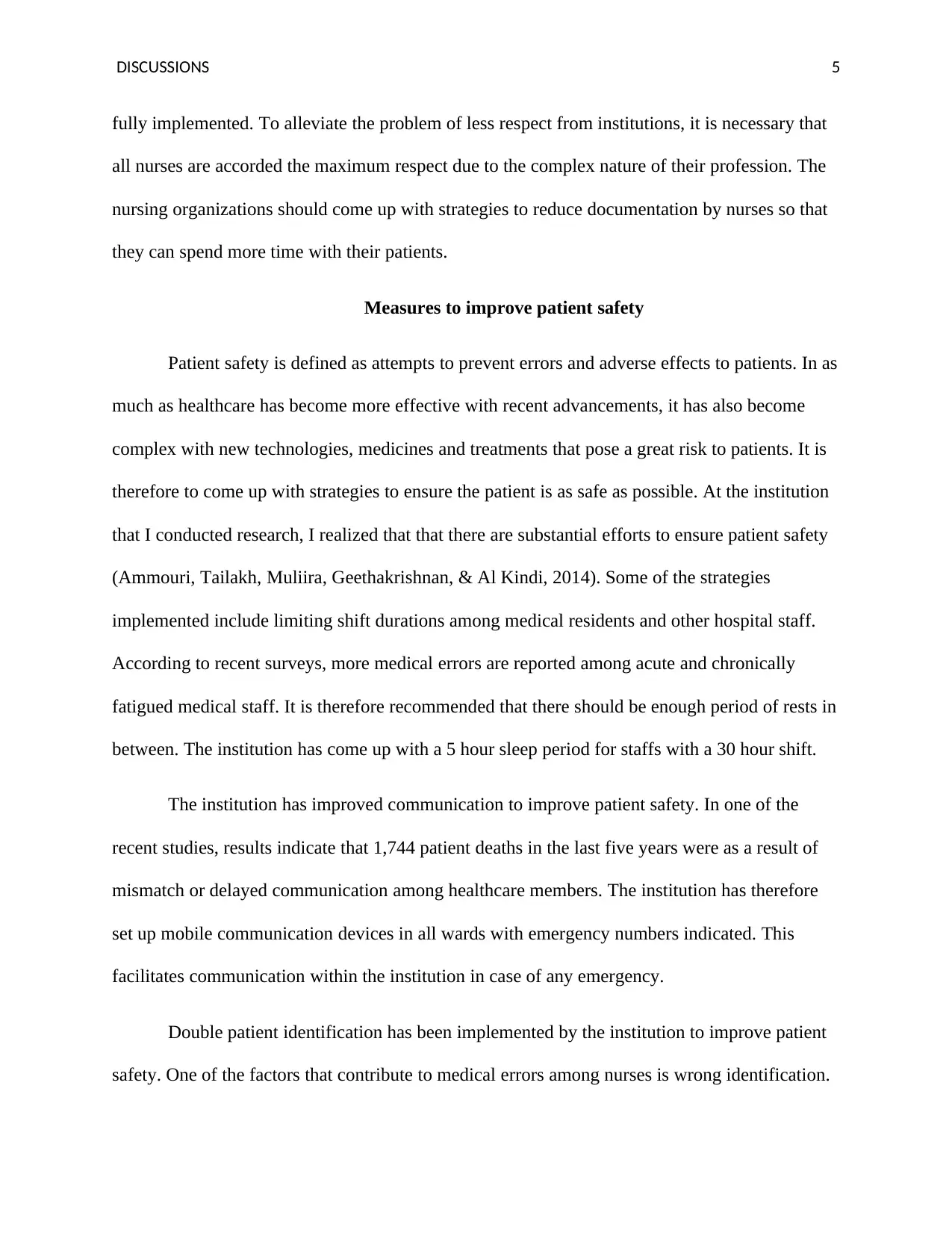
DISCUSSIONS 5
fully implemented. To alleviate the problem of less respect from institutions, it is necessary that
all nurses are accorded the maximum respect due to the complex nature of their profession. The
nursing organizations should come up with strategies to reduce documentation by nurses so that
they can spend more time with their patients.
Measures to improve patient safety
Patient safety is defined as attempts to prevent errors and adverse effects to patients. In as
much as healthcare has become more effective with recent advancements, it has also become
complex with new technologies, medicines and treatments that pose a great risk to patients. It is
therefore to come up with strategies to ensure the patient is as safe as possible. At the institution
that I conducted research, I realized that that there are substantial efforts to ensure patient safety
(Ammouri, Tailakh, Muliira, Geethakrishnan, & Al Kindi, 2014). Some of the strategies
implemented include limiting shift durations among medical residents and other hospital staff.
According to recent surveys, more medical errors are reported among acute and chronically
fatigued medical staff. It is therefore recommended that there should be enough period of rests in
between. The institution has come up with a 5 hour sleep period for staffs with a 30 hour shift.
The institution has improved communication to improve patient safety. In one of the
recent studies, results indicate that 1,744 patient deaths in the last five years were as a result of
mismatch or delayed communication among healthcare members. The institution has therefore
set up mobile communication devices in all wards with emergency numbers indicated. This
facilitates communication within the institution in case of any emergency.
Double patient identification has been implemented by the institution to improve patient
safety. One of the factors that contribute to medical errors among nurses is wrong identification.
fully implemented. To alleviate the problem of less respect from institutions, it is necessary that
all nurses are accorded the maximum respect due to the complex nature of their profession. The
nursing organizations should come up with strategies to reduce documentation by nurses so that
they can spend more time with their patients.
Measures to improve patient safety
Patient safety is defined as attempts to prevent errors and adverse effects to patients. In as
much as healthcare has become more effective with recent advancements, it has also become
complex with new technologies, medicines and treatments that pose a great risk to patients. It is
therefore to come up with strategies to ensure the patient is as safe as possible. At the institution
that I conducted research, I realized that that there are substantial efforts to ensure patient safety
(Ammouri, Tailakh, Muliira, Geethakrishnan, & Al Kindi, 2014). Some of the strategies
implemented include limiting shift durations among medical residents and other hospital staff.
According to recent surveys, more medical errors are reported among acute and chronically
fatigued medical staff. It is therefore recommended that there should be enough period of rests in
between. The institution has come up with a 5 hour sleep period for staffs with a 30 hour shift.
The institution has improved communication to improve patient safety. In one of the
recent studies, results indicate that 1,744 patient deaths in the last five years were as a result of
mismatch or delayed communication among healthcare members. The institution has therefore
set up mobile communication devices in all wards with emergency numbers indicated. This
facilitates communication within the institution in case of any emergency.
Double patient identification has been implemented by the institution to improve patient
safety. One of the factors that contribute to medical errors among nurses is wrong identification.
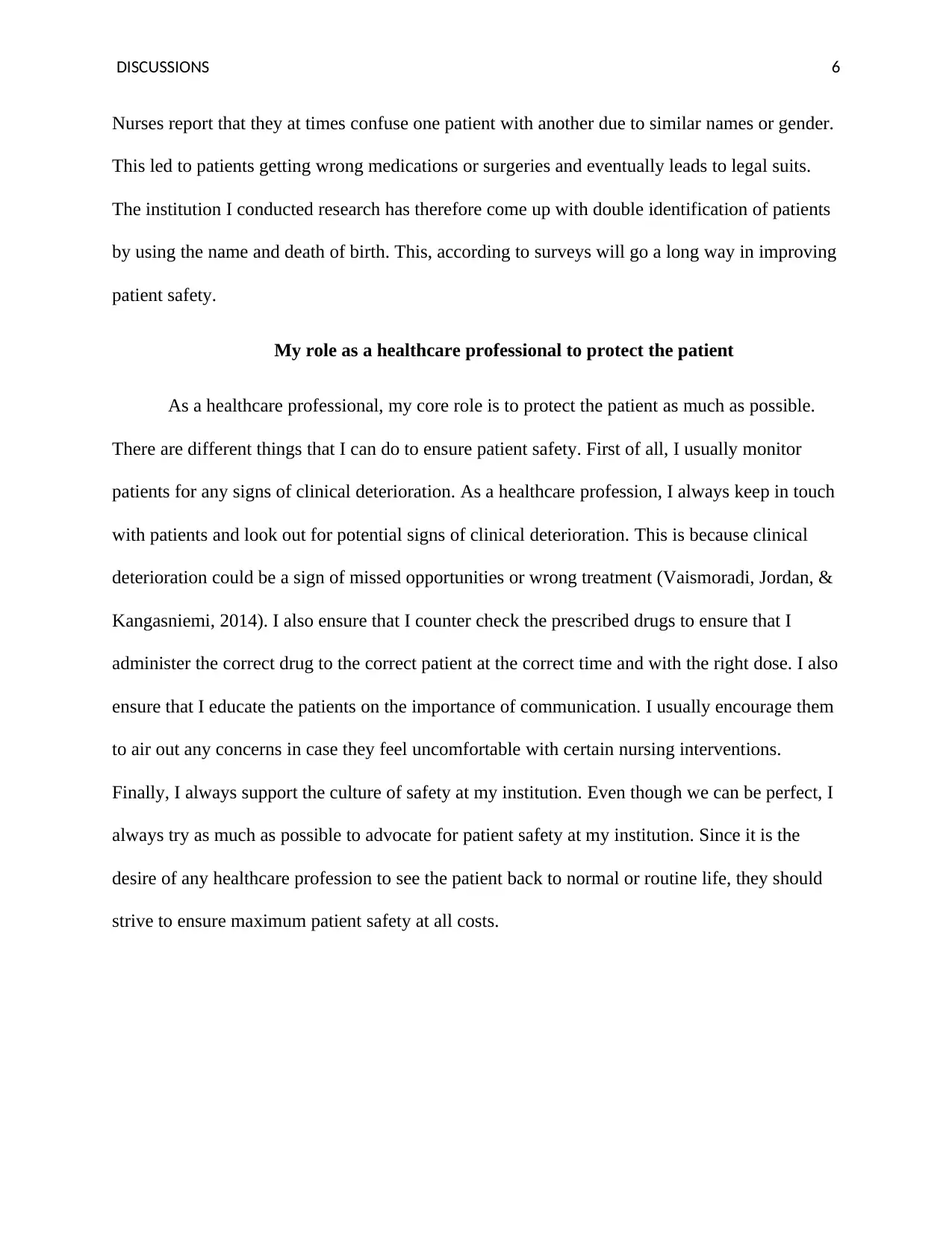
DISCUSSIONS 6
Nurses report that they at times confuse one patient with another due to similar names or gender.
This led to patients getting wrong medications or surgeries and eventually leads to legal suits.
The institution I conducted research has therefore come up with double identification of patients
by using the name and death of birth. This, according to surveys will go a long way in improving
patient safety.
My role as a healthcare professional to protect the patient
As a healthcare professional, my core role is to protect the patient as much as possible.
There are different things that I can do to ensure patient safety. First of all, I usually monitor
patients for any signs of clinical deterioration. As a healthcare profession, I always keep in touch
with patients and look out for potential signs of clinical deterioration. This is because clinical
deterioration could be a sign of missed opportunities or wrong treatment (Vaismoradi, Jordan, &
Kangasniemi, 2014). I also ensure that I counter check the prescribed drugs to ensure that I
administer the correct drug to the correct patient at the correct time and with the right dose. I also
ensure that I educate the patients on the importance of communication. I usually encourage them
to air out any concerns in case they feel uncomfortable with certain nursing interventions.
Finally, I always support the culture of safety at my institution. Even though we can be perfect, I
always try as much as possible to advocate for patient safety at my institution. Since it is the
desire of any healthcare profession to see the patient back to normal or routine life, they should
strive to ensure maximum patient safety at all costs.
Nurses report that they at times confuse one patient with another due to similar names or gender.
This led to patients getting wrong medications or surgeries and eventually leads to legal suits.
The institution I conducted research has therefore come up with double identification of patients
by using the name and death of birth. This, according to surveys will go a long way in improving
patient safety.
My role as a healthcare professional to protect the patient
As a healthcare professional, my core role is to protect the patient as much as possible.
There are different things that I can do to ensure patient safety. First of all, I usually monitor
patients for any signs of clinical deterioration. As a healthcare profession, I always keep in touch
with patients and look out for potential signs of clinical deterioration. This is because clinical
deterioration could be a sign of missed opportunities or wrong treatment (Vaismoradi, Jordan, &
Kangasniemi, 2014). I also ensure that I counter check the prescribed drugs to ensure that I
administer the correct drug to the correct patient at the correct time and with the right dose. I also
ensure that I educate the patients on the importance of communication. I usually encourage them
to air out any concerns in case they feel uncomfortable with certain nursing interventions.
Finally, I always support the culture of safety at my institution. Even though we can be perfect, I
always try as much as possible to advocate for patient safety at my institution. Since it is the
desire of any healthcare profession to see the patient back to normal or routine life, they should
strive to ensure maximum patient safety at all costs.
⊘ This is a preview!⊘
Do you want full access?
Subscribe today to unlock all pages.

Trusted by 1+ million students worldwide
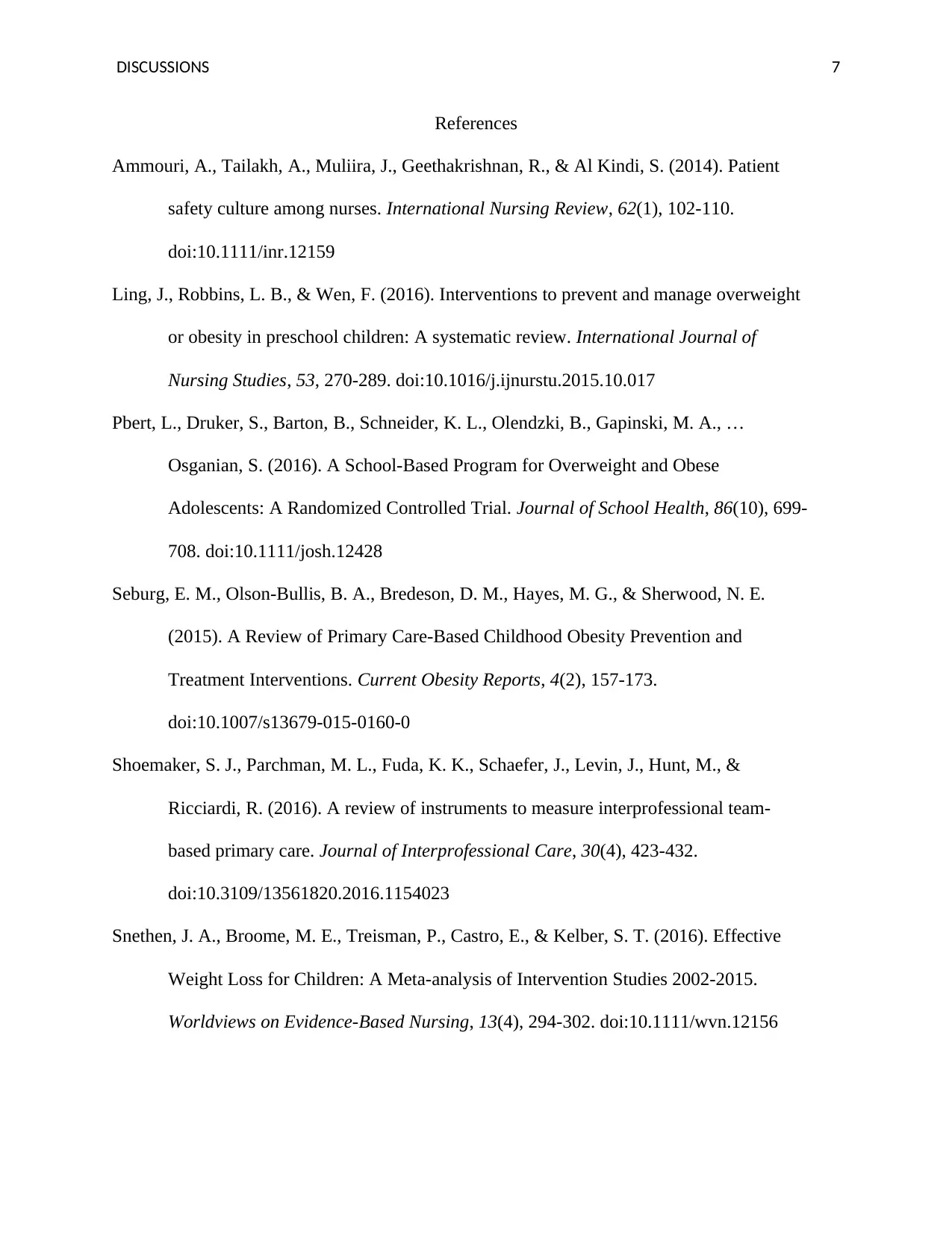
DISCUSSIONS 7
References
Ammouri, A., Tailakh, A., Muliira, J., Geethakrishnan, R., & Al Kindi, S. (2014). Patient
safety culture among nurses. International Nursing Review, 62(1), 102-110.
doi:10.1111/inr.12159
Ling, J., Robbins, L. B., & Wen, F. (2016). Interventions to prevent and manage overweight
or obesity in preschool children: A systematic review. International Journal of
Nursing Studies, 53, 270-289. doi:10.1016/j.ijnurstu.2015.10.017
Pbert, L., Druker, S., Barton, B., Schneider, K. L., Olendzki, B., Gapinski, M. A., …
Osganian, S. (2016). A School-Based Program for Overweight and Obese
Adolescents: A Randomized Controlled Trial. Journal of School Health, 86(10), 699-
708. doi:10.1111/josh.12428
Seburg, E. M., Olson-Bullis, B. A., Bredeson, D. M., Hayes, M. G., & Sherwood, N. E.
(2015). A Review of Primary Care-Based Childhood Obesity Prevention and
Treatment Interventions. Current Obesity Reports, 4(2), 157-173.
doi:10.1007/s13679-015-0160-0
Shoemaker, S. J., Parchman, M. L., Fuda, K. K., Schaefer, J., Levin, J., Hunt, M., &
Ricciardi, R. (2016). A review of instruments to measure interprofessional team-
based primary care. Journal of Interprofessional Care, 30(4), 423-432.
doi:10.3109/13561820.2016.1154023
Snethen, J. A., Broome, M. E., Treisman, P., Castro, E., & Kelber, S. T. (2016). Effective
Weight Loss for Children: A Meta-analysis of Intervention Studies 2002-2015.
Worldviews on Evidence-Based Nursing, 13(4), 294-302. doi:10.1111/wvn.12156
References
Ammouri, A., Tailakh, A., Muliira, J., Geethakrishnan, R., & Al Kindi, S. (2014). Patient
safety culture among nurses. International Nursing Review, 62(1), 102-110.
doi:10.1111/inr.12159
Ling, J., Robbins, L. B., & Wen, F. (2016). Interventions to prevent and manage overweight
or obesity in preschool children: A systematic review. International Journal of
Nursing Studies, 53, 270-289. doi:10.1016/j.ijnurstu.2015.10.017
Pbert, L., Druker, S., Barton, B., Schneider, K. L., Olendzki, B., Gapinski, M. A., …
Osganian, S. (2016). A School-Based Program for Overweight and Obese
Adolescents: A Randomized Controlled Trial. Journal of School Health, 86(10), 699-
708. doi:10.1111/josh.12428
Seburg, E. M., Olson-Bullis, B. A., Bredeson, D. M., Hayes, M. G., & Sherwood, N. E.
(2015). A Review of Primary Care-Based Childhood Obesity Prevention and
Treatment Interventions. Current Obesity Reports, 4(2), 157-173.
doi:10.1007/s13679-015-0160-0
Shoemaker, S. J., Parchman, M. L., Fuda, K. K., Schaefer, J., Levin, J., Hunt, M., &
Ricciardi, R. (2016). A review of instruments to measure interprofessional team-
based primary care. Journal of Interprofessional Care, 30(4), 423-432.
doi:10.3109/13561820.2016.1154023
Snethen, J. A., Broome, M. E., Treisman, P., Castro, E., & Kelber, S. T. (2016). Effective
Weight Loss for Children: A Meta-analysis of Intervention Studies 2002-2015.
Worldviews on Evidence-Based Nursing, 13(4), 294-302. doi:10.1111/wvn.12156
Paraphrase This Document
Need a fresh take? Get an instant paraphrase of this document with our AI Paraphraser
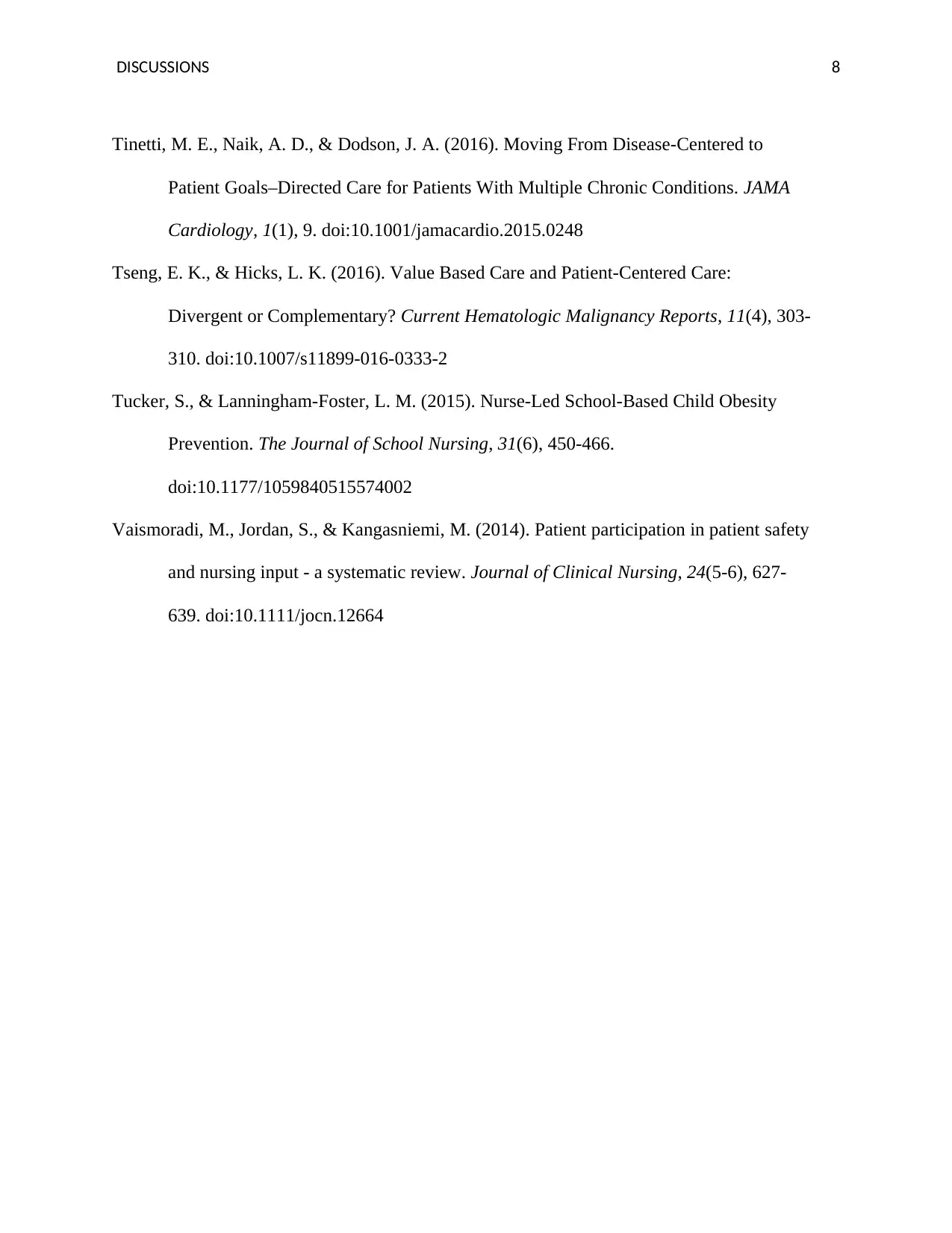
DISCUSSIONS 8
Tinetti, M. E., Naik, A. D., & Dodson, J. A. (2016). Moving From Disease-Centered to
Patient Goals–Directed Care for Patients With Multiple Chronic Conditions. JAMA
Cardiology, 1(1), 9. doi:10.1001/jamacardio.2015.0248
Tseng, E. K., & Hicks, L. K. (2016). Value Based Care and Patient-Centered Care:
Divergent or Complementary? Current Hematologic Malignancy Reports, 11(4), 303-
310. doi:10.1007/s11899-016-0333-2
Tucker, S., & Lanningham-Foster, L. M. (2015). Nurse-Led School-Based Child Obesity
Prevention. The Journal of School Nursing, 31(6), 450-466.
doi:10.1177/1059840515574002
Vaismoradi, M., Jordan, S., & Kangasniemi, M. (2014). Patient participation in patient safety
and nursing input - a systematic review. Journal of Clinical Nursing, 24(5-6), 627-
639. doi:10.1111/jocn.12664
Tinetti, M. E., Naik, A. D., & Dodson, J. A. (2016). Moving From Disease-Centered to
Patient Goals–Directed Care for Patients With Multiple Chronic Conditions. JAMA
Cardiology, 1(1), 9. doi:10.1001/jamacardio.2015.0248
Tseng, E. K., & Hicks, L. K. (2016). Value Based Care and Patient-Centered Care:
Divergent or Complementary? Current Hematologic Malignancy Reports, 11(4), 303-
310. doi:10.1007/s11899-016-0333-2
Tucker, S., & Lanningham-Foster, L. M. (2015). Nurse-Led School-Based Child Obesity
Prevention. The Journal of School Nursing, 31(6), 450-466.
doi:10.1177/1059840515574002
Vaismoradi, M., Jordan, S., & Kangasniemi, M. (2014). Patient participation in patient safety
and nursing input - a systematic review. Journal of Clinical Nursing, 24(5-6), 627-
639. doi:10.1111/jocn.12664
1 out of 8
Related Documents
Your All-in-One AI-Powered Toolkit for Academic Success.
+13062052269
info@desklib.com
Available 24*7 on WhatsApp / Email
![[object Object]](/_next/static/media/star-bottom.7253800d.svg)
Unlock your academic potential
Copyright © 2020–2025 A2Z Services. All Rights Reserved. Developed and managed by ZUCOL.





